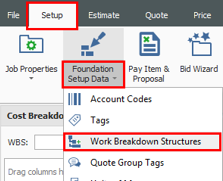Products
Solutions
Resources
9977 N 90th Street, Suite 250 Scottsdale, AZ 85258 | 1-800-637-7496
© 2024 InEight, Inc. All Rights Reserved | Privacy Statement | Terms of Service | Cookie Policy | Do not sell/share my information

The Work Breakdown Structure (WBS) feature lets you create a job in one format and present it in a multitude of other formats depending on the need. This can be beneficial when the estimating team or the proposal team needs to present the estimate in a preferred format to a design firm, engineering company, client or any other stakeholders. WBS retains the same relationship between items as in the original estimate and only changes the view and how items are arranged in the hierarchy.
The Work Breakdown Structure provides flexibility to create other formats, such as Construction Specific Institute (CSI) MasterFormat or UniFormat. Use WBS formats when you need to have multiple variations and summary reports of an estimate. This is useful in cases where you want to show different estimates in one particular way, perhaps for a repeat client or designer.
After you have your general information entered and set up for a format, you can build your hierarchy. This lets you organize and define the information in a format that works best for you. You have the ability to build your hierarchy from scratch, or you can use a template. The default quantity (1.00) & unit of measure (Each) are populated in the WBS hierarchies. You can change the default quantity and unit of measure as needed. After a WBS item has been created, it is listed in the Foundation Setup Data Register.
From the main tabs, select the Setup tab.
Click the Foundation Setup Data drop down button, and then select Work Breakdown Structures.

From the Work Breakdown Structure, select the Actions tab.
Under the Edit section, select New. A new Work Breakdown Structure record opens.
Enter a Code and Description for the WBS item.
From the Setup data block, a period is automatically populated in the Hierarchy Separator field.
The Hierarchy Separator is used to separate the parent cost items from the subordinate and terminal cost items.
Select the Tag 1 drop-down arrow, and then select Concrete.
In the Details data block, build your hierarchy by entering items into the Code and Description fields.
In the Details data block, leave the Quantity as the default. Enter in a Unit of Measure for each item.
When completed, click OK.
The Cost Breakdown Structure (CBS) Register shows you the WBS Code and Description fields. From here, you can assign your WBS items to any of your CBS items.
From the main tabs, select the Estimate tab.
Select Cost Breakdown Structure (CBS). The Cost Breakdown Structure (CBS) Register opens.
Right click on any column header, and then select Column Chooser.
In the Customize dialog box, scroll down until you find WBS: Test WBS.
Drag and drop both columns into the CBS column headers.
Select a cost item, and then click in the empty field from the WBS column you dragged and dropped into the CBS. Click the arrow icon that shows to the right of that field. The Work Breakdown Structure Detail Register opens.
Select the WBS item to assign to the cost item. When completed, click OK.
The WBS selected in the previous step is now populated in that cost item’s WBS field.
A subordinate cost item can inherit the parent cost item WBS assignment. This feature saves you time by automatically inputting the WBS parent value rather than having to manually add the parent WBS.
You can still change the subordinate’s cost item code.
In the Work Breakdown Structure View Register you can:
Only the unit cost is affected when the quantity has been changed.
When you are creating multiple WBS items, you are able to group the data and view the Work Breakdown Structure hierarchy.
The Quantity Roll-Up feature lets you roll up and derive at the parent item’s quantity from detailed level takeoff quantities, while eliminating the need to manually calculate these roll-up values. Estimate is capable of automatically rolling up quantities (versus a manual roll-up) directly in the WBS by using the Auto-Quantity (Roll-Up) field.
When a Quantity Roll-Up code is assigned and the Auto Quantity (Roll-Up) option is checked for the item in the WBS register, rollup of the item's quantity happens automatically. When unchecked, you can manually enter a Quantity for the WBS item. This enables you to better control if the WBS Quantities need to be calculated automatically or entered manually.
From the main tabs, select the Estimate tab.
In the Breakdown Structure section, select Work Breakdown Structure. The Work Breakdown Structure View Register opens.
From the WBS tree, click the WBS drop-down arrow, and then select your WBS item.
In the Cost Items data block, you can view which cost items utilized by a WBS item that you select. You can also view the total cost roll up of assigned cost items.
Expand your utilized cost item by clicking the + icon in the CBS Position Code. You can now view the associated resources to your cost item and WBS item.
Similar to the Cost Breakdown Structure register, the Work Breakdown Structure View register can filter to a specified WBS level.
Additional Information
9977 N 90th Street, Suite 250 Scottsdale, AZ 85258 | 1-800-637-7496
© 2024 InEight, Inc. All Rights Reserved | Privacy Statement | Terms of Service | Cookie Policy | Do not sell/share my information
